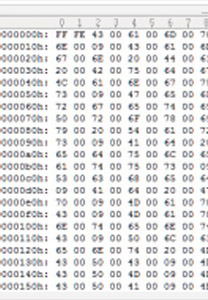The DHWI Art in Odd Places award goes to: Digital Forensics & BitCurator
BitCurator is a project that I’m rather excited about, although not wholly for the developers’ original reasons. It’s a set of Linux-based OSS’s which “incorporate the functionality of many digital forensics tools” for the purposes of humanities research and archiving. The site says, “the BitCurator project is an effort to build, test, and analyze systems and software for incorporating digital forensics methods into the workflows of a variety of collecting institutions.”

The forensic and “bit” part of the project involves reading and recording the hexadecimal static data that exists on readable drives, to incorporate extra information into a data pull, keeping both original file order and original disk order. This results in files which contain sections and clips of extra information; much of it hexadecimal gobbledygook [<– see left side], and some of it useful notes on the hex data [<– see right side].
For example, many cultural creators’ have been making digital copies of their work for decades now, whether on floppy disks, CDs, or on a stack of hard drives, and retirement is a-coming for many. This package would allow archivists and collecting institutions to rip the bits off any version of an old digital media and then process the file using forensic software that search out meaningful data, like phone numbers, emails, names, et al., along with the file histories and notes on the hex data.
This is where the poesis begins: the archivist and the criminal investigator share a common interest in scraping the data out of its digital bit corners. One to condemn and the other to accolade, but both to pursue the deepest level of trackable data available. this crossover is, to me, indicative of the ways in which power, proof, accreditation, and institutionalization function and perpetuate taxonomies of power/knowledge and intellectual ownership.
It’s interesting that there is such a deep crossover with law enforcement and archival selection/appraisal, but it makes sense considering that the practice of archiving comes from a legal/judicial tradition, to create evidentiary value that was originally intended to support the legitimacy of the State [person or department].
The ways in which digital forensics is needed — or considered needed — to pursue the depth of information that this ability allows for is disturbing; and powerful. For if all I need is the old floppy disk of someone to obtain all the phone numbers they ever placed in a file on the disk –ever– then not only did the thrift store just get more interesting, but the volume of information available on any given individual just increased exponentially.
As for me, I’m excited about the possibility of taking a set of digital data [say, oh, Dorothy Allison’s disks of Bastard out of Carolina from the Lesbian Herstory Archives] and extracting the bit code to get hexadecimal information on the digitalia. Then applying a text visualizer to the hexidemical information to see what other patterns appear across the typologies of produced bits of data. I think I would need a structured taxonomy of input ahead of time, but perhaps I would also be surprised to see what digital patterns equivocate to a text.
Download Bitcurator here: [http://mith.umd.edu/research/project/bitcurator/]

1 comment